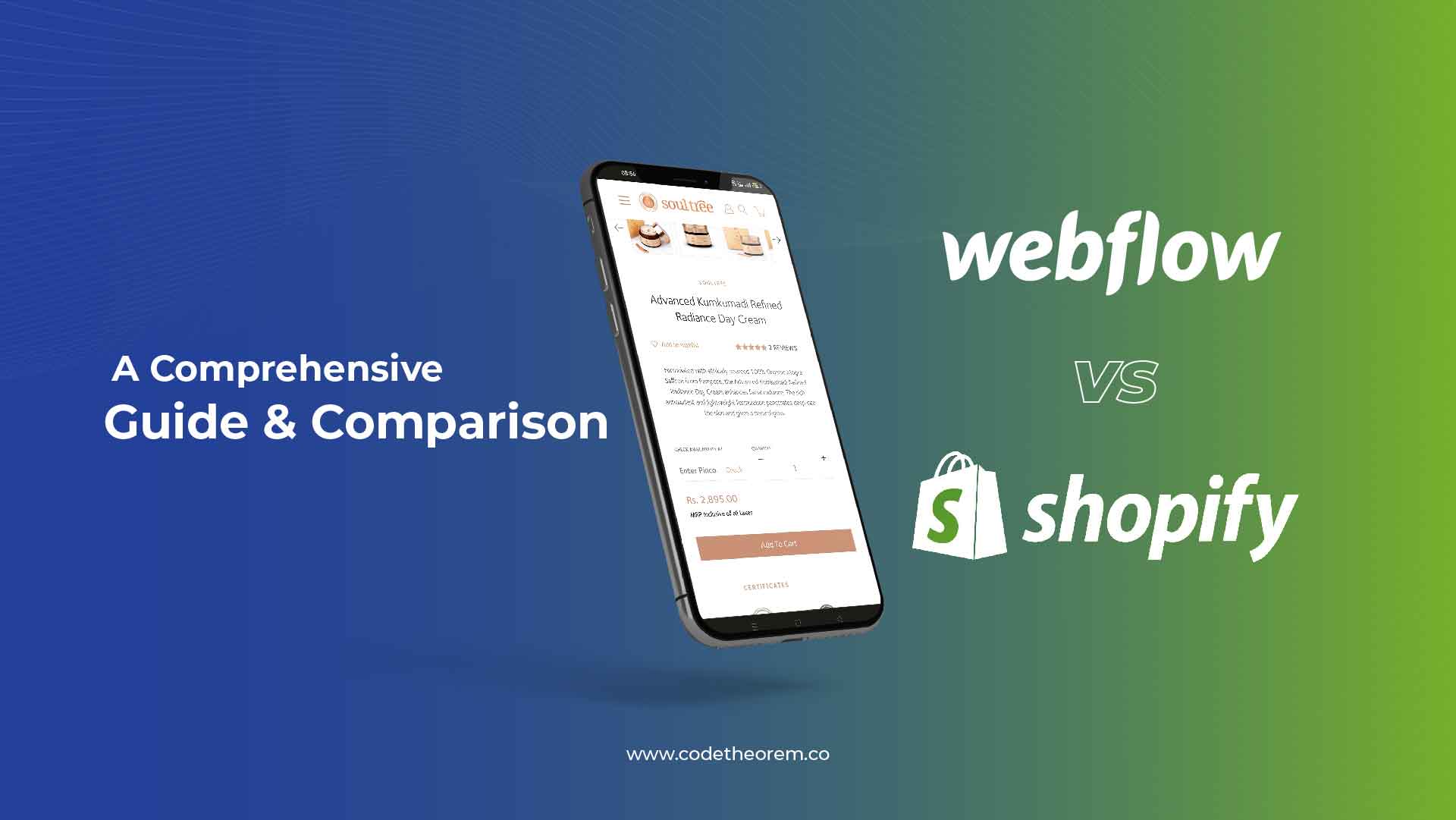There is no doubt that eCommerce is a huge booming industry today. So it’s only natural if you want to open an online store or expand your offline store. In that case, you must choose the right eCommerce platform. For example, you can choose between Webflow and Shopify. Webflow vs Shopify is one of the most popular discussions when selecting an eCommerce platform.
This blog will walk you through a detailed comparative study between Webflow vs Shopify. Learn from Webflow and Shopify differences in eCommerce features to pricing plans. Let’s start with understanding the key differences and similarities between Webflow and Shopify.
Article content
What is Shopify?
Shopify is a renowned eCommerce platform that allows you to set up an online store quickly. The platform’s primary focus is to help people sell products online easily.
Tobias Lütke founded Shopify over ten years ago when he decided to sell snowboards. However, he soon realized it was super challenging to sell snowboards online without an easy-to-use eCommerce platform. That’s when he decided to create one himself, and Shopify was born.
Since then, Shopify has always worked towards making the eCommerce experience better for everyone. Today, Shopify is the leading eCommerce platform designed for businesses of all sizes. Hundreds of entrepreneurs from over 175 countries trust Shopify to help sell their products. Whether you sell online, on social media, in-store, or in your backyard, Shopify has you covered.
What is Webflow?
Webflow is an all-in-one custom website builder, CMS platform, and hosting provider. It allows over 35,00,000 designers and teams to create, collaborate and scale beautiful websites. What’s best is that you don’t have to learn coding to use Webflow.
Webflow had an unmatched, sleek, and intuitive visual editor. Probably the best-in-class, but there’s a bit of a learning curve. However, you don’t have to worry, as the Webflow University feature offers various comprehensive tutorials. However, With the help of these, you can master the platform.
Webflow first became popular among freelance web designers. It spent five years building for the freelance design community. Later those users took it in-house at larger businesses. Today, therefore Webflow powers a site to run ad campaigns and complete documentation for a programming language. It works as a replacement for WordPress. Also, it has room to expand into new areas of development beyond websites in the coming months.
Webflow vs Shopify: Key Similarities and Differences
Let’s look at the significant similarities and differences between Webflow and Shopify.
Similarities:
- Both Webflow and Shopify are eCommerce platforms
- Shopify and Webflow both are no-code platforms. But, with Shopify themes, you have to work in Liquid template language to customize
- Both the platforms offer free and paid templates
- Robust blogging engines
- Both Shopify eCommerce and Webflow eCommerce offer ample, extensive learning resources. They include blog posts, video tutorials, and guides
- Shopify and Webflow both come with marketing features. Each of these offers basic email funnels and coupon code creation
- The pricing plans are almost the same
- Both the platforms allow you to create custom rules for shipping rates
- Free shipping
- Free themes
- Built-in SEO
Differences:
| Webflow | Shopify |
|---|---|
| Webflow was initially built for design purposes. Later on, it offered eCommerce features | Shopify has always been an eCommerce platform |
| Less advanced features and limited third-party apps | Get more and a wide range of third-party apps |
| No integrated analytics tracking abilities | You can track your marketing campaign performance with Shopify |
| Webflow doesn’t offer POS integration | Offers POS (point-of-sale) system integration |
| Webflow offers a free plan. Once you are familiar with the core suite of features, you can pay to take your website live. | Shopify doesn’t offer a free plan but it gives a 14-day free trial. Post that, you must subscribe to one of the premium packages to continue using its service. |
| Limited payment gateway options | A wider range of payment gateways |
| Offers more creative freedom | Limited customization |
| Webflow doesn’t offer a mobile app | Manage your store while you’re on the go with a mobile app |
Webflow vs Shopify Comparison:
Both have similar web design and eCommerce features. But they have a different target and focus. So let’s explore their features in detail with that in mind.
Ease of use – Webflow vs Shopify
When talking of ease of use, Shopify checks that off. It is mainly centred around online store development and management. No worries if you’re a newbie and unfamiliar with operating an online store. Shopify offers all the tools with exceptional ease of use. It is an entirely no-code platform. Thus, it’s known as one of the most user-friendly platforms.
First, it provides a beneficial onboarding checklist. This list helps you cover all the main tasks for starting an online store. Second, you get the two most easy-to-use editors. The WYSIWYG editor allows you to control the front end of your store. You can easily move elements around to change the theme, images, font, colours, etc.
On the other hand, the dashboard allows you to control the back end of your store. It gives you the tools to add products, build collections, and create discounts. In addition, you can easily manage your inventory, shipping, and taxes.
On the other hand, Webflow offers more flexibility and customization. It is also a no-code platform. But, it comes with a significant learning curve. It will take time for you to get familiar with all the features and learn to operate the platform without fuss.
Webflow is a cross between a CMS platform and a website builder. It has an expansive editor and dashboard tailored for web designers and developers. Thus, it can get a tad overwhelming when starting. But, the platform does offer a five-minute tutorial. The video helps you understand the complicated editor and main tools.
That said, Webflow will only require a big-time investment. It’s more suitable for design and web development enthusiasts. So, choose Shopify eCommerce if you’re a beginner or a casual seller who wants to start an online store quickly.
Design Flexibility and Templates – Webflow vs Shopify
Firstly, The look of your online store is important. It impacts the users’ decision to stick around and browse your website. Talking of which one has an extensive library of professional themes and templates.
Shopify offers various ready-to-use, free, and paid templates and themes. No doubt they’re professional looking with impressive designs. So, You can set up your online store in minutes using the available templates. But, it lacks customization. As a result, your store won’t stand out among the existing Shopify stores.
Shopify themes and Shopify templates are written in Liquid code. So if you want a custom, unique look for your online store, you need to contact a developer. Moreover, Shopify helps you connect with an expert directly on their Shopify Experts website.
Webflow, on the other hand, offers great design flexibility. It is more tailored for design and development professionals. Thus, Webflow themes are the best choice for a unique online store look. The Webflow visual editor is quite advanced but requires a time investment to master. On the other hand, it offers you the flexibility to unleash your creativity and customize designs the way you want. Best part? above all,It provides superb interaction and animation tools. You can easily integrate After Effects and Lottie systems. This helps you control the playback of vector animations through system interactions. Hence, you get complete design freedom with Webflow themes.
SEO – Webflow vs Shopify
Today, building an online store is not enough. It is equally important to attract traffic, start making sales and increase it down the line. For that, you need powerful tools that can help you market effectively. This is where a vigorous set of SEO and marketing tools is vital. So, let’s look at which performs better in this case.
Since Webflow is a combination of a website builder and CMS, it does well for SEO. The codes are always clean, and it also includes the following Webflow SEO features:
- Meta Titles
- Custom URLs
- Image alt tags to allow search engines to crawl better and rank your website
- XML sitemaps to list a website’s important pages, ensuring Google finds and crawls them all.
Shopify, too, offers various SEO tools. It also offers SEO tips while you upload your products. Still, what it lacks is keyword support. You can download third-party apps to help fill the gap. But remember, you have to pay an extra cost for those.
You probably know that blogging is an essential part of SEO. And luckily, both Shopify and Webflow offer robust blogging engines. But, they offer limited tools. For example, with Shopify, you can display categories, comments, and an RSS feed. Yet, if blogging is a core practice for you, it’s better to choose Webflow.
Why? Because Webflow resembles WordPress. It has nearly all CMS features. In addition, you can edit straight onto the page and add extra elements directly into the code. Thus, no surprise that Webflow SEO features are the best for blogging.
eCommerce Features – Webflow vs Shopify
When your main goal is to start an online store, eCommerce features are what you should consider first. So let’s compare the Shopify vs Webflow features to conclude which one is better for eCommerce.
1. Products
With Shopify, you can sell unlimited products and their variants. Thus, it is best suited for large stores. Furthermore, you can easily manage a higher volume of items through its bulk product import feature. Whereas, Webflow eCommerce is a little restricted in this case. Here, the number of products you can sell depends on your chosen pricing plan.
2. Inventory Management
Although Webflow offers out-and-out inventory management, it cannot compete with eCommerce Shopify websites. As mentioned earlier, Webflow introduced eCommerce features recently (in 2018). It offers limited but good features like inventory tracking and out-of-stock warnings and allows adding variants. Shopify, on the other hand, provides a robust inventory management system. It is the best among various other eCommerce builders. Some of the major features include setting different prices for variants. Also, allowing customers to browse by size, collection, colour, and more using the tagging feature.
3. Shipping
Are you a dropshipper? If not so, shipping tools are a must for you to deliver your products. Shopify is an expert in this area. For instance, You easily get discounts through its partnerships with renowned names. Examples include USPS, UPS, DHL Express, and more. Further, prominent shipping features include:
- Firstly, Buy and print your shipping labels that make it easier to get orders in the mail.
- Calculate your shipping costs
- Set your shipping location
- Modify the shipping prices as per the weight or destination.
A lot of these features are still underdeveloped on Webflow. For example, although it allows you to set shipping rates manually, it can’t beat the Shopify shipping features. To avail of that functionality, you will need support from third-party apps. Hence, Shopify eCommerce is the best platform for a simple selling process.
4. Abandoned Cart Recovery
Again Shopify eCommerce websites win over Webflow eCommerce certainly in this section. Shopify offers abandoned cart recovery across all its paid and free plans. So, regardless of your monthly subscription, you can easily catch all the incomplete orders. However, with Webflow, you need to download third-party apps for abandoned cart delivery.
Integrations – Shopify vs Webflow
Both Shopify and Webflow offer third-party integrations. Shopify offers an app store with thousands of tools and above all Shopify plugins to improve the functioning of your website. But Webflow doesn’t offer an app store. This could be because it targets more skilled and tech-savvy builders. Still, if you want to add some Webflow plugins or integrations, you can do it through Zapier. As for Shopify plugins, all you need to do is install them.
Migrating Process – Which One is Easier?
Are you bored with your existing website builder? Or do you feel that it’s just not suitable for your store? In that case, transferring your website to a new website builder is the right option.
For instance, If you decide to move your store to Shopify, you can do that in many ways. Shopify gives you two options to do it manually. Firstly, one is by copy-pasting your content across. The second is uploading the data through a CSV file. But there are limitations to this. Above all, It does not allow you to copy the whole page. Instead, you can copy and paste just the products and customer details. Shopify also gives you the option to use third-party apps. Or simply connect with a Shopify Expert (additional high cost).
However, the process is trickier if you decide to move your online store to the Shopify alternative Webflow. Similarly, you can use CSV files to transfer the products. In addition, you can recreate your store’s design through the Webflow visual editor. To import your products, firstly you must create a new collection. Next, upload your CSV file. However, this step can be time-consuming as you must ensure the access file is in the correct format.
Thus, Shopify offers a more straightforward migrating process than most Shopify alternatives.
Performance and Security
Performance and security are the two most important factors of an eCommerce store. Not because your customers share loads of personal data. But because you have to be sure about keeping it safe.
Fortunately, Shopify and Webflow are PCI DSS (Payment Card Industry Data Security Standard) compliant. Hence, This means both have the necessary measures to keep customers’ information secure. Especially their credit and debit card details.
Additionally, both platforms accord SSL Security (Secure Sockets Layer) certificates as standard. This protects any sensitive information, encrypting and preventing it from hackers. Thus, both platforms are equally potent regarding performance and security.
Pricing Plans – Webflow vs Shopify
Although Shopify and Webflow prices are similar, Shopify prices give better value for money. Here’s a comparative pricing plan table to help you out:
| Plans | Webflow Prices | Shopify Prices |
|---|---|---|
| Standard | 29$ (monthly) | 29$ (monthly) |
| Plus | 74$ (monthly) | 79$ (monthly) |
| Advanced | 212$ (monthly) | 299$ (monthly) |
Webflow vs Shopify: Pros and Cons
Before winding up, let’s take a look at all the pros and cons of Shopify vs Webflow:
Cons:
| Webflow | Shopify |
|---|---|
| Pay to take your website live. | Additional fee for using third-party payment gateways. |
| Intimidating interface for newbies or non-professionals. | Expensive if you want to use too many Shopify plugins or apps. |
| No POS integration. | Most of the sophisticated templates are costly. |
| It only offers basic email marketing and product management features. | Although it provides ample features, it has a steeper learning curve than some competitors. |
| Customer support is limited to live chat and emails. | You have limited design customization. |
| No mobile app. | – |
| No in-built Webflow plugins. | – |
Pros:
| Webflow | Shopify |
|---|---|
| Best in the class visual editor. | Add unlimited products to your online storefront. |
| Provides fast hosting | It is a no-code platform. You don’t need any coding knowledge to start an online store quickly. |
| Get access to animation and interaction tools. | Excellent customer service team with 24/7 over call support. |
| You don’t need any coding knowledge to use Webflow. | Offers the most extensive set of eCommerce features than most of the Shopify alternatives. |
| Free plan available | Integrates with your POS to allow seamless online and offline selling. |
Final thoughts
In short, after reading this comprehensive guide on Webflow vs Shopify, you can easily decide which of the two is best suitable for your needs. With that said, both the Shopify alternative Webflow and Shopify itself are remarkable eCommerce platforms. So, each one of them has its own set of limitations and advantages. However, the rest depends on your purpose. For instance, What features are you looking for? And the amount of knowledge you have about setting up an eCommerce store.
If you have any more questions, you can connect with Code Theorem. We can help you build a top-class Webflow or Shopify website within half the time of traditional development. if not then you can drop your queries and anything else that you want to add in the comment section below.


















